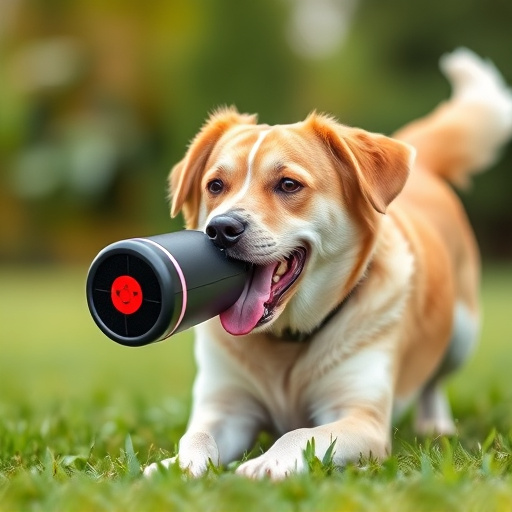The dog deterrent market offers humane electronic pet repellents like ultrasonic and EMF devices that use safe electromagnetic fields or sound waves to discourage dogs from entering areas. EMC Certification Requirements ensure these products meet RF emission standards, preventing harmful interference with electronics and safeguarding human and pet health. Customizable settings allow users to adapt sensitivity levels and activation zones based on animal behaviors and environments. This certification is vital for reliable, effective deterrence and market acceptance in the growing pet care sector.
“Revolutionize your pet management with the latest in technology: an electronic dog deterrent system. This comprehensive guide explores innovative Dog Repellent technologies, focusing on Customizable Settings and essential EMC Certification requirements for safety and compliance.
Learn how these advanced features provide effective deterrence, allowing you to train and control canine behavior. From understanding the science behind repellents to ensuring your system meets EMC Certification standards, this article covers everything dog owners need to know for a harmonious co-existence with their furry friends.”
- Understanding Dog Repellent Technologies
- EMC Certification: Ensuring Safety and Compliance
- Customizable Settings for Effective Deterrence
Understanding Dog Repellent Technologies
The market for dog deterrents has evolved significantly, incorporating various technologies aimed at humanely training and protecting properties from unwanted canine visitors. Understanding these innovations is crucial when selecting an effective yet safe solution. One prominent approach involves electronic pet deterrents, devices that use electromagnetic fields or ultrasonic waves to discourage dogs from entering specific areas without harming them. These products often come with adjustable settings, allowing users to customize sensitivity levels based on their needs and the behavior of their pets.
When considering a dog repellent, it’s essential to be aware of EMC Certification Requirements. This certification guarantees that the device emits electromagnetic fields within safe limits, ensuring no adverse effects on human health or other electronic equipment. In terms of functionality, ultrasonic repellents emit high-frequency sound waves that are unpleasant to dogs but generally inaudible to humans. Meanwhile, electromagnetic field (EMF) dog deterrents use low-level energy fields to discourage dogs without causing pain. Both technologies have their merits and can be chosen based on factors like effectiveness, weather resistance, and specific usage scenarios, always keeping the well-being of pets and the environment at the forefront.
EMC Certification: Ensuring Safety and Compliance
Electronic pet deterrents, designed to keep dogs away from certain areas, must meet stringent EMC (ElectroMagnetic Compatibility) certification requirements to ensure safety and compliance. This certification process verifies that the device emits no harmful electromagnetic interference (EMI) that could potentially affect other electronic equipment or pose risks to human health. For dog repellent devices, this means meeting specific standards for radio frequency (RF) emissions, ensuring they operate within safe limits and do not cause any adverse effects on pets or people nearby.
The EMC certification process involves rigorous testing to ensure the device’s performance doesn’t interfere with other electronic systems. It also guarantees that the dog repellent functions reliably in various environments without causing or receiving unwanted electromagnetic signals. Adhering to these requirements is crucial for manufacturers, as it not only ensures product safety and effectiveness but also opens up avenues for wider market acceptance, especially considering the growing demand for pet care products that prioritize both efficiency and animal welfare.
Customizable Settings for Effective Deterrence
One of the key advantages of modern electronic pet deterrents is their customizable settings, which offer both versatility and effectiveness. These devices are designed to adapt to different environments and animal behaviors, ensuring optimal performance as a dog repellent. Users can adjust sensitivity levels, activation zones, and even choose between various training modes, catering to specific needs. For instance, setting a higher sensitivity for small, fast animals like squirrels or cats, while employing a lower setting for larger dogs, ensures precise deterrence without unnecessary triggers.
Furthermore, understanding EMC Certification Requirements for these devices is crucial for their efficient operation. Electromagnetic Compatibility (EMC) certification guarantees that the deterrent’s electromagnetic emissions comply with standards, minimizing interference with other electronic devices nearby. This certification also assures users of the product’s reliability and safety, especially in households with multiple electronic gadgets, ensuring a seamless and effective deterrence experience for both pet owners and their furry companions.
When it comes to choosing a dog repellent, understanding technology, safety standards, and customizable settings are key. Opting for a product with EMC certification ensures both effectiveness and safety, meeting crucial requirements like those set by Dog Repellent EMC Certification Standards. By leveraging these features, pet owners can find the perfect balance between deterring unwanted canine behavior and maintaining their peace of mind, making it a game-changer in navigating the world of dog repellents.
